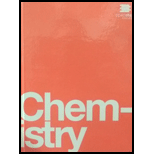
Concept explainers
If a 2.5 A current is run through a circuit for 35 minutes, how many coulombs of charge moved through the circuit?
Interpretation:
The coulombs of charge moved through the circuit should be calculated.
Concept Introduction:
Current is defined as the rate of charge passed through the circuit. It is mathematically represented as follows:
Here, I is current, Q is charge and t is time.
The SI unit of current is Ampere denoted by symbol A.
Thus, 1 A current means 1 C of charge is passed through a wire every 1 second.
Or,
Answer to Problem 1E
5250 C
Explanation of Solution
Given Information:
The current passed through the wire is 2.5 A and time is 35 min.
Calculation:
The current is related to charge and time as follows:
Thus, charge can be calculated from current as:
Putting the values,
Thus, the charge moving through the circuit is 5250 C.
Want to see more full solutions like this?
Chapter 17 Solutions
Chemistry by OpenStax (2015-05-04)
Additional Science Textbook Solutions
College Physics
General Chemistry: Principles and Modern Applications (11th Edition)
Chemistry: A Molecular Approach (4th Edition)
Organic Chemistry (9th Edition)
Chemistry: Structure and Properties (2nd Edition)
Introductory Chemistry (6th Edition)
- It took 150. s for a current of 1.25 A to plate out 0.109 g of a metal from a solution containing its cations. Show that it is not possible for the cations to have a charge of 1+.arrow_forwardAn aqueous solution of an unknown salt of gold is electrolyzed by a current of 2.75 amps for 3.39 hours. The electroplating is carried out with an efficiency of 93.0%, resulting in a deposit of 21.221 g of gold. a How many faradays are required to deposit the gold? b What is the charge on the gold ions (based on your calculations)?arrow_forwardA baby's spoon with an area of 6.25 cm2 is plated with silver from AgNO3 using a current of 2.00 A for two hours and 25 minutes. (a) If the current efficiency is 82.0%, how many grams of silver are plated? (b) What is the thickness of the silver plate formed (d=10.5g/cm3) ?arrow_forward
- A lead storage battery delivers a current of 6.00 A for one hour and 22 minutes at a voltage of 12.0 V. (a) How many grams of lead are converted to PbSO4? (b) How much electrical energy is produced in kilowatt hours?arrow_forwardThe mass of three different metal electrodes, each from a different galvanic cell, were determined before and after the current generated by the oxidation-reduction reaction in each cell was allowed to flow for a few minutes. The first metal electrode, given the label A, was found to have increased in mass; the second metal electrode, given the label B, did not change in mass; and the third metal electrode, given the label C, was found to have lost mass. Make an educated guess as to which electrodes were active and which were inert electrodes, and which were anode(s) and which were the cathode(s).arrow_forward
 Chemistry by OpenStax (2015-05-04)ChemistryISBN:9781938168390Author:Klaus Theopold, Richard H Langley, Paul Flowers, William R. Robinson, Mark BlaserPublisher:OpenStax
Chemistry by OpenStax (2015-05-04)ChemistryISBN:9781938168390Author:Klaus Theopold, Richard H Langley, Paul Flowers, William R. Robinson, Mark BlaserPublisher:OpenStax Principles of Modern ChemistryChemistryISBN:9781305079113Author:David W. Oxtoby, H. Pat Gillis, Laurie J. ButlerPublisher:Cengage Learning
Principles of Modern ChemistryChemistryISBN:9781305079113Author:David W. Oxtoby, H. Pat Gillis, Laurie J. ButlerPublisher:Cengage Learning ChemistryChemistryISBN:9781305957404Author:Steven S. Zumdahl, Susan A. Zumdahl, Donald J. DeCostePublisher:Cengage Learning
ChemistryChemistryISBN:9781305957404Author:Steven S. Zumdahl, Susan A. Zumdahl, Donald J. DeCostePublisher:Cengage Learning Chemistry: An Atoms First ApproachChemistryISBN:9781305079243Author:Steven S. Zumdahl, Susan A. ZumdahlPublisher:Cengage Learning
Chemistry: An Atoms First ApproachChemistryISBN:9781305079243Author:Steven S. Zumdahl, Susan A. ZumdahlPublisher:Cengage Learning
 Chemistry: Principles and ReactionsChemistryISBN:9781305079373Author:William L. Masterton, Cecile N. HurleyPublisher:Cengage Learning
Chemistry: Principles and ReactionsChemistryISBN:9781305079373Author:William L. Masterton, Cecile N. HurleyPublisher:Cengage Learning





